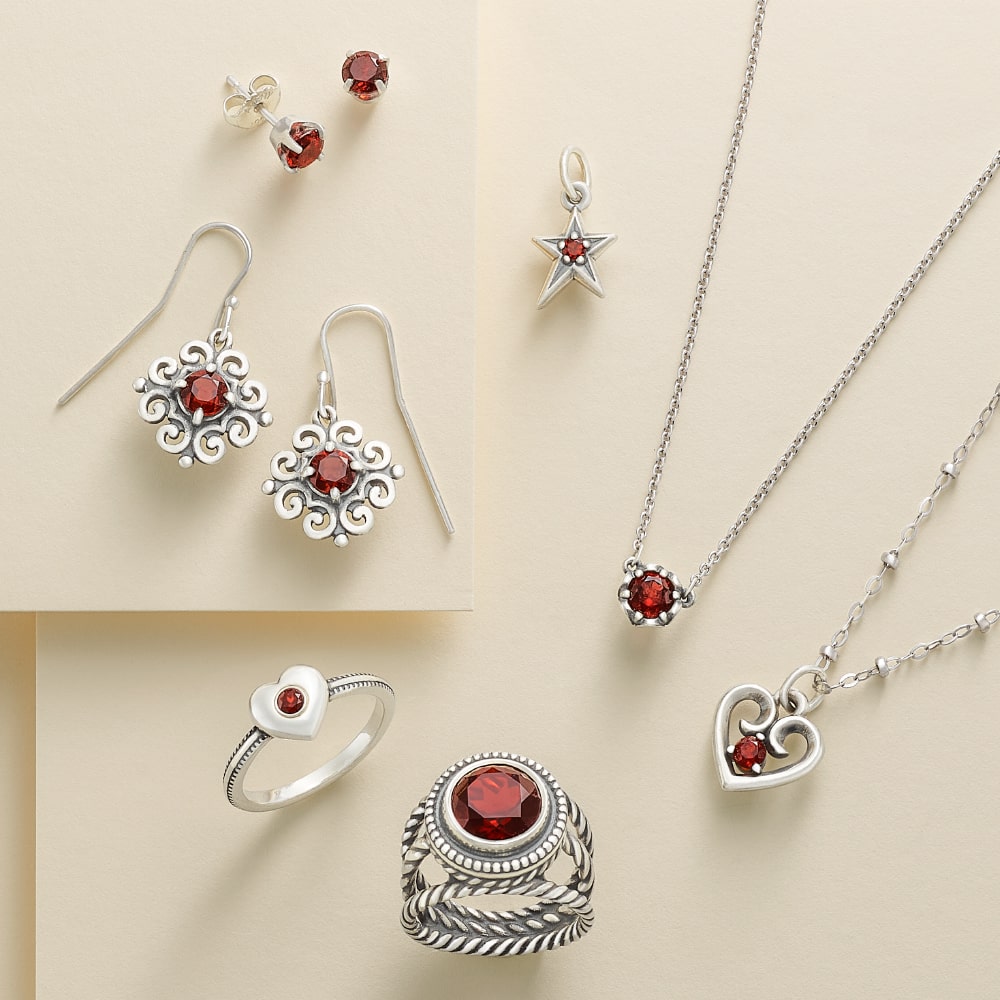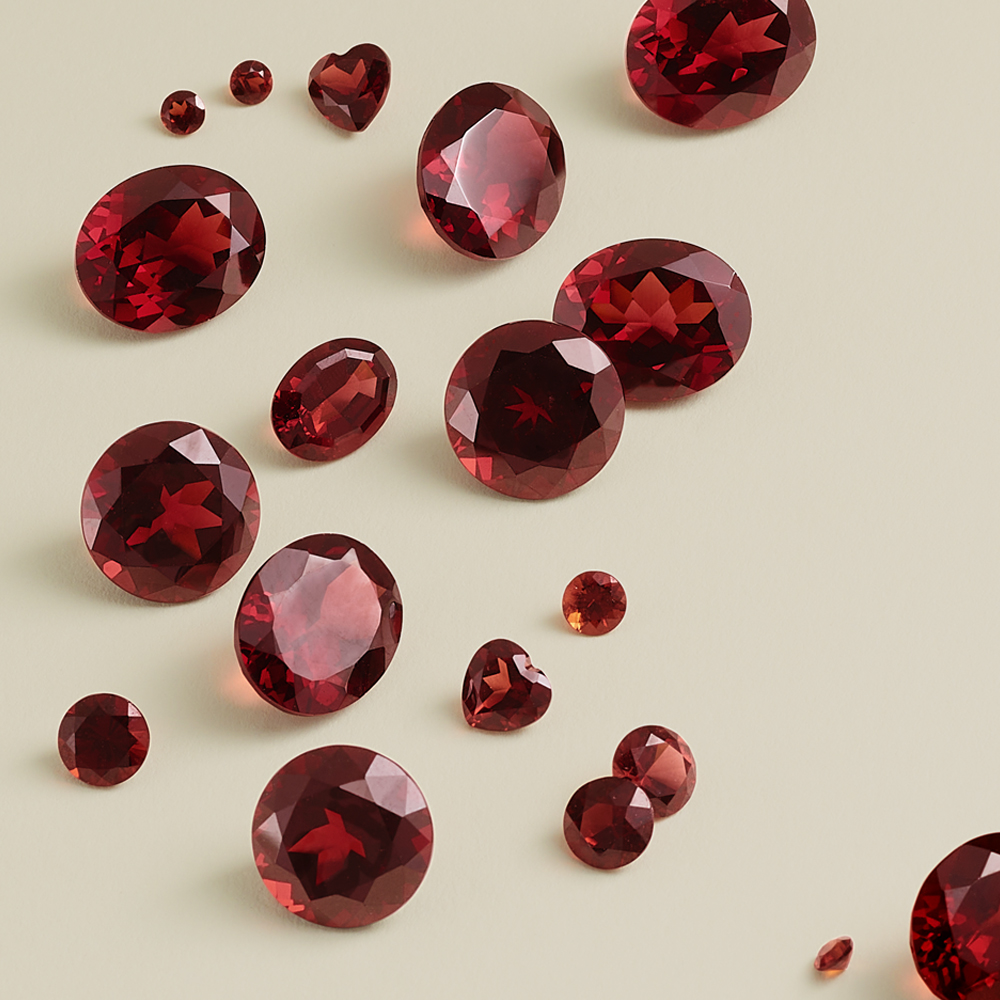January Birthstone

The birthstone for January is often celebrated for its diverse range of hues and fascinating historical background, matching its visual beauty with an equally meaningful story. In this in-depth guide, we’re providing a detailed look at the garnet, delving into its origins, properties and significance in various cultures while also providing practical tips for proper care of this beloved January birthstone.
Whether you admire garnets in their traditionally rich, deep red or have an eye for their green, orange, or nearly violet counterparts, we will take you on an interesting journey through this beautiful birthstone’s past, present and future.
What is January’s Birthstone?
 January boasts the vibrant garnet as its birthstone, a gem that seamlessly combines beauty with deep historical significance. Originating from the Latin term “Garanatus,” meaning “seed-like,” Garnet draws parallels with the appearance of pomegranate seeds.
January boasts the vibrant garnet as its birthstone, a gem that seamlessly combines beauty with deep historical significance. Originating from the Latin term “Garanatus,” meaning “seed-like,” Garnet draws parallels with the appearance of pomegranate seeds.
Though the classic deep red is often the first shade to come to mind, Garnet’s spectrum is surprisingly broad, ranging from greens to oranges and even some rare blues. Beyond its visual allure, this gemstone embodies Januarys vigor and renewal, making it an emblematic start to the calendar year. For those born in January or gem enthusiasts, garnet offers a captivating look at nature’s artistry.
The Garnet Birthstone
The January garnet birthstone has captured a millennia of human appreciation, holding a special place in the world of jewelry and our society as a whole.
It’s not just its association with the birth month of January that makes it special, but the intricate blend of colors, shades and varieties it presents. These distinctions allow garnet to be versatile, catering to different tastes and styles in jewelry. Its expansive range and nuances make this stone a favorite for many, offering a broad range of options for those searching for January birthstone jewelry.
What Color is Garnet?
Often pictured as a gemstone of lustrous deep red, garnets actually come in a wide variety of colors. In fact, even the opacity of garnet can vary widely, ranging from transparent to completely opaque. Still, the quintessential red garnet remains an iconic representation in jewelry and folklore.
Garnet Shades and Varieties
Garnet’s diverse color palette can be attributed to its unique composition. Garnets are not a singular mineral but rather a group of closely related minerals, each imparting its distinct hue to the gemstone. The complex interplay of these minerals under varying geological conditions gives birth to the spectrum of shades we see in garnets today.
This is one of the most common garnets and is recognized by its deep red to violet-red hues. Almandine garnets owe their color to the presence of iron and aluminum in their composition.
Often confused with Almandine due to its red shades, Pyrope garnets are typically more vibrant. Their composition is rich in magnesium, which imparts a lively color.
A manganese-rich garnet, Spessartine boasts a range from oranges to earthy browns. Its vibrant coloration makes it one of the more sought-after types of garnet in jewelry.
The diversity in Grossular garnets is impressive. Ranging from greens to beige and even almost transparent, this garnet owes its varied shades to its calcium-rich structure, which can include traces of other elements, creating a spectrum of colors.
Rich in calcium and iron, Andradite garnets showcase colors from yellow-green to a deep brownish appearance. They're known for their brilliance and high refractive index, making them especially shiny.
The only consistently green garnet, Uvarovite is a dazzling bright green shade due to its high chromium content.
Beyond their stunning range of colors, the unique chemical compositions of these garnet varieties also affect their physical properties, such as refractive index, density and hardness scale. This not only influences their appearance but also their suitability for different types of jewelry and their durability over time.
Garnet Birthstone Meaning & History
The history of garnet dates back thousands of years, and throughout time, the gemstone has played an important part in many different cultures, mythologies, and fashion styles alike.
Where is Garnet Found?
 Ancient artifacts and texts suggest that garnets were known to many early civilizations, with evidence of garnet beads and gems traded extensively during the Bronze Age. Their durability and captivating hues made them highly desirable in various regions of the ancient world.
Ancient artifacts and texts suggest that garnets were known to many early civilizations, with evidence of garnet beads and gems traded extensively during the Bronze Age. Their durability and captivating hues made them highly desirable in various regions of the ancient world.
In the heart of Europe, the Czech Republic (once known as Bohemia), became a nexus for garnet mining. The rich garnet deposits found here played a pivotal role in making Bohemia the chief supplier for Europe, especially during the Middle Ages. These Bohemian garnets, known for their deep red hue, are still cherished today.
While the early Egyptians sourced garnets primarily from the Nile Delta, offering them as tributes to pharaohs and using them as ornate jewelry, the global quest for these gems has expanded considerably over the millennia.
Today's garnets can be traced to many varied sources:
Leading the charge, nations like Tanzania and Mozambique are renowned for their rich garnet mines, yielding stones with unique colors and characteristics.
Areas in India and Sri Lanka are rich in garnet deposits. Their mines often produce a wide range of garnet varieties, adding to the global garnet palette.
Brazil, with its vast mineral wealth, also contributes to the world's garnet supply. Brazilian garnets are particularly prized for their clarity and color range.
Interestingly, garnets from different regions exhibit subtle differences in hue, clarity, and composition, resulting from the distinct geological conditions of each area. These variances add layers to the garnet narrative, making each stone a unique chapter in the gem's global journey.
The History of Garnet
Garnet's history is as multifaceted as the gemstone itself, unfolding across multiple civilizations and empires. Its allure has been timeless, and its significance varied yet deeply rooted in every culture it touched.
If we look back to ancient history, the Egyptian civilization held garnets in high regard. Pharaohs, the powerful rulers of ancient Egypt, adorned themselves with garnet necklaces, valuing the stone for its visual splendor and its symbolic representation of life and vitality. For them, garnets were more than jewelry pieces; they were revered tokens embodying eternity and strength.
From there, the legacy of garnet traveled from the deserts of Egypt to Rome. In the heart of the Roman Empire, garnets took on a more pragmatic role. Beyond their use as jewelry, garnets became an essential tool for the bureaucracy. They were intricately carved to create signet rings, which were then used to stamp and authenticate official documents with wax seals. But their symbolism wasn't lost; garnets were also revered as talismanic gems. Romans believed that wearing them could bestow protection, strength, and prosperity.
As the world transitioned into the medieval era, the myths and beliefs surrounding garnets evolved. The Dark Ages, marred by wars and plagues, saw garnets as protective stones and amulets. The belief was that garnets had the power to ward off diseases and misfortunes. Crusaders, setting off for distant lands, often adorned their armor with garnets.
Fast forward to the Victorian era, a period marked by grandeur, art, and romanticism. Garnets, with their deep red hues, resonated with the opulence of the time. The Victorian elite, always in pursuit of luxury, saw garnets as the epitome of elegance. Jewelry designs of this era prominently featured garnets, echoing the affluence and artistic renaissance of the period.
What Does Garnet Symbolize?
Throughout the ages, the meanings associated with Garnet have been as varied as its hues. Primarily, the deep-red Garnet is often likened to the heart and symbolizes deep love, commitment, and passion. It's also often viewed as a symbol of quick returns, ensuring the safety of travelers.
Here are just a few of the symbolic meanings garnet is known for:
At its core, the deep-red garnet, reminiscent of the human heart, has been a longstanding symbol of profound emotions. Its rich, captivating shade has made it an emblem of deep-seated love, unwavering commitment, and fiery passion. In many cultures, gifting a garnet is seen as an act of enduring love and dedication
Beyond love, the garnet has also been esteemed as a protective talisman, especially for those embarking on journeys. The gemstone's luminescence is believed to light up the night, guiding travelers and ensuring their swift and safe return. This belief has its roots in ancient tales where garnets acted as beacons in the dark, illuminating paths and keeping dangers at bay.
Garnet's allure is also closely tied to abundance. The gem, with its radiant glow, is often associated with prosperity in various forms—be it wealth, success, or personal growth. Its presence is believed to attract positive energies, ushering in periods of abundance and fortune.
Garnet Birthstone Care & Cleaning
While garnets are relatively hardy, ranging from 6.5 to 7.5 on the Mohs scale of hardness, protecting their brilliance requires some special attention. Here are a few key care and cleaning tips to ensure your garnet gemstone remains as beautiful as the first day you wore it:
- Make regular inspections a part of your routine. Before cleaning, inspect your garnet jewelry. Look for any signs of damage, like scratches or loose settings. This can help you decide on the cleaning method and avoid exacerbating any existing issues.
- Clean your garnet properly. A simple cleaning routine will help make the most of your garnet’s sparkle and shine.
- Pre-rinse with warm water: Start by gently rinsing the garnet with lukewarm water. This step helps remove any surface dust or particles that might scratch the gem during the cleaning process.
- Prepare a mild soap solution: In a small bowl, mix a few drops of mild, non-detergent soap with warm water. Avoid using soaps with harsh chemicals or fragrances, as they can dull the garnet’s shine.
- Gently and thoroughly clean the stone: Dip a soft-bristled brush, like a toothbrush, into the soap solution. Gently brush the garnet, paying extra attention to crevices and the underside where dirt can accumulate. The brush's soft bristles ensure the stone is cleaned without any abrasive action.
- Rinse thoroughly: Rinse the garnet under a stream of lukewarm water to remove any soap residue. Ensure all soap is washed away, as any residue can make the stone look cloudy.
- Dry with care: Using a soft, lint-free cloth, gently pat the garnet dry. Avoid rubbing vigorously, as this can lead to scratches. If possible, let the garnet air-dry completely before storing it to avoid trapping moisture.
- Know how to safely store your garnet. To prevent scratches and damage, always store your garnet jewelry separately from other pieces. Using individual soft pouches or compartments in a jewelry box is ideal.
- Avoid extremes. Steer clear of exposing garnets to harsh chemicals, like those found in cosmetics or household cleaners. Additionally, sudden temperature changes can be detrimental, so it’s wise to remove garnet jewelry before entering a sauna or diving into a cold pool.
- Periodically schedule a professional cleaning. Consider getting your garnet professionally cleaned once or twice a year. Professionals can ensure a thorough cleaning and can also inspect the stone and its setting for any issues.
January Birthstone Jewelry
Garnet, given its range and history, is a prime candidate for diverse jewelry pieces. From bold statement rings to delicate necklaces, its ability to complement varied metals and styles is unparalleled. Whether your personal style is understated and classic or eclectic and fashion-forward, you’ll find that the garnet stone can be a stunning addition to your everyday wardrobe.
Shop Garnet Birthstone Jewelry
at James Avery Artisan Jewelry
At James Avery Artisan Jewelry, we’ve crafted a collection that is a proud testament to the garnet birthstone’s legacy. Each piece, whether it’s a pendant or a ring, demonstrates our commitment to craftsmanship and the storied history of this gem. Celebrate the January birthstone, or simply immerse yourself in garnet’s rich heritage when you explore our curated collection of garnet birthstone jewelry today.
Explore our full collection of garnet gemstone jewelry today.